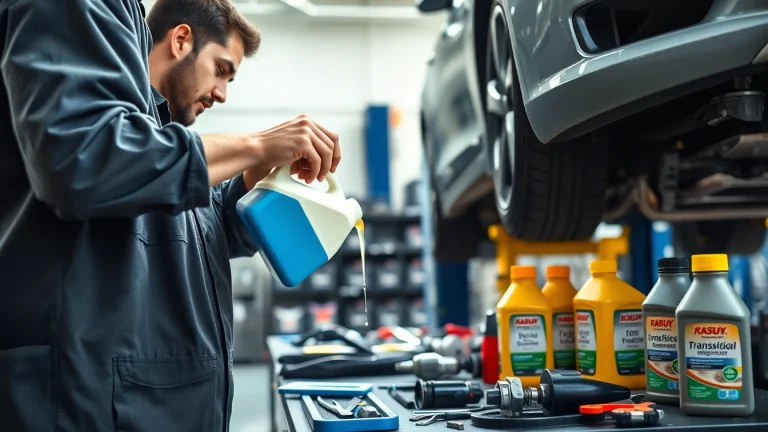
Essential Guide to Automatic Transmission Fluid: Importance, Types, and Maintenance
Understanding Automatic Transmission Fluid
What is Automatic Transmission Fluid?
Automatic Transmission Fluid (ATF) is a specialized hydraulic fluid used in vehicles equipped with automatic transmissions. Its primary function is to facilitate smooth gear shifting and provide necessary lubrication for the transmission components. ATF also acts as a coolant and contains additives to prevent corrosion and oxidation. The composition of ATF can vary based on the vehicle manufacturer, which is why it’s crucial to use the correct type specified in your owner’s manual.
Functions and Importance of ATF
The significance of ATF cannot be overstated, as it serves several vital roles in the operation of an automatic transmission:
- Lubrication: ATF reduces friction and wear on the internal parts of the transmission, ensuring a long lifespan for components such as gears and bearings.
- Cooling: By transporting heat away from the transmission, ATF helps maintain optimal operating temperatures, preventing overheating.
- Hydraulic Functionality: ATF creates hydraulic pressure required to operate valves and clutches within the transmission, facilitating smooth transitions between gears.
- Cleaning: Additives within ATF help prevent sludge and deposits from forming, keeping the transmission clean and efficient.
Without proper ATF levels and quality, your vehicle’s performance can deteriorate significantly, leading to costly repairs or even total transmission failure. Hence, regular maintenance of this fluid is essential for vehicle longevity.
Common Myths About Transmission Fluid
Several myths surround Automatic Transmission Fluid, leading to misunderstandings and improper maintenance practices. Here are some prevalent misconceptions:
- Myth 1: Transmission fluid never needs to be changed.
*Reality:* Like engine oil, ATF degrades over time and must be changed according to manufacturer recommendations to ensure optimal performance. - Myth 2: All transmission fluids are the same.
*Reality:* There are different types of ATFs designed for various vehicles. Using the wrong type can cause severe damage. - Myth 3: A low fluid level is not a cause for concern.
*Reality:* Low ATF levels can lead to overheating and inadequate lubrication, potentially causing transmission failure.
Types of Automatic Transmission Fluid
Different Types and Their Uses
ATFs can be categorized based on their chemical composition and use for particular vehicle types:
- Conventional ATF: Derived from refined petroleum, this type is used in older vehicles and certain models requiring a basic fluid.
- Synthetic ATF: Formulated with synthetic base oils and advanced additives, synthetic ATFs provide superior lubrication, heat resistance, and protection against wear. They are often recommended for modern transmissions.
- Multi-vehicle ATF: Designed to meet the specifications of various manufacturers, these fluids offer versatility for vehicles from different manufacturers, making them ideal for repair shops.
- Specific ATF formulations: Certain manufacturers develop proprietary fluids tailored to their vehicle’s unique specifications. Always consult your vehicle’s manual to ensure compatibility.
Synthetic vs. Conventional ATF
One of the critical factors to consider when selecting ATF is whether to choose synthetic or conventional options. Below are some comparisons:
Synthetic ATF:
- Better resistance to oxidation, resulting in longer intervals between changes.
- Offers superior lubrication properties, which can enhance performance in extreme conditions.
- More effective at cleaning and minimizing sludge buildup.
Conventional ATF:
- Typically less expensive upfront, though may require more frequent changes.
- Can be adequate for older vehicle models with simpler transmission systems.
- May not perform well under extreme driving conditions, such as towing or high-speed driving.
Cross-Referencing Automatic Transmission Fluids
It’s essential to cross-reference ATFs to ensure compatibility, especially if you’re considering using an aftermarket fluid. Various resources are available online that provide cross-references for ATF specifications. You can also check manufacturer websites or consult with automotive professionals to find suitable alternatives. Remember that using non-recommended fluids can void warranties and lead to performance issues.
How to Change Your Automatic Transmission Fluid
Tools You Need for the Job
Changing your automatic transmission fluid can be a DIY task if you have the proper tools and knowledge. Below is a list of essential tools you will need:
- Socket wrench and sockets
- Fluid pump or funnel
- Catch basin or pan for old fluid
- Transmission fluid dipstick
- Safety goggles and gloves
Steps to a Successful Fluid Change
To ensure a successful transmission fluid change, follow these outlined steps:
- Preparation: Make sure the engine is turned off and has cooled. Drive the vehicle to circulate the old fluid, which can help with draining.
- Access the fluid pan: Safely lift the vehicle using jack stands, and locate the transmission pan. Use a socket wrench to remove the bolts.
- Drain old fluid: Allow the old fluid to fully drain into a catch basin.
- Replace filter (if applicable): Some vehicles require a filter change. Replace it as per manufacturer instructions.
- Refill with new fluid: Using a fluid pump or funnel, refill the transmission with the recommended automatic transmission fluid.
- Check fluid level: Use the dipstick to verify that the fluid level is appropriate.
- Test drive: After changing, take the vehicle for a test drive to ensure everything operates smoothly.
Common Mistakes to Avoid
While changing your ATF can be straightforward, several common mistakes can lead to issues:
- Not using the right fluid: Always refer to your owner’s manual to ensure proper fluid specifications.
- Failure to check fluid levels: Neglecting to check the dipstick after refilling can result in either overfilling or underfilling.
- Ignoring leaks: If you notice transmission fluid leaking post-service, it requires immediate attention.
- Skipping filter changes: If your transmission has a replaceable filter, neglecting it can lead to poor performance and contamination.
Signs You Need to Change Your Transmission Fluid
Visual Indicators of Fluid Quality
Monitoring the condition of your ATF is essential. Here are observable signs indicating a necessary change:
- Color: Healthy ATF should be a bright red color. Dark or brownish fluid suggests breakdown and contamination.
- Odor: A burnt smell indicates overheating and deterioration.
- Particles: If you notice debris or metal shavings in the fluid, it’s indicative of internal wear.
Performance Issues and Warning Signs
A decline in transmission performance can signal the need for a fluid change. Common symptoms to watch for include:
- Slipping gears or difficulty in shifting
- Unusual noises when shifting
- Delayed or harsh engagement when changing gears
- A warning light on the dashboard related to transmission issues
Expert Recommendations on Fluid Maintenance
To extend the life of your transmission, follow these expert maintenance tips:
- Check the fluid level regularly, ideally every oil change.
- Consider using synthetic ATF for better performance and longer intervals.
- Change your fluid and filter based on your vehicle’s manufacturer recommendations, but no longer than every 30,000 to 50,000 miles, especially for severe driving conditions.
Frequently Asked Questions About Automatic Transmission Fluid
How Often Should You Change ATF?
The frequency of changing your automatic transmission fluid varies based on driving conditions and vehicle type. A general guideline is every 30,000 to 50,000 miles. However, vehicles that often tow, drive in stop-and-go traffic, or are exposed to extreme weather may require more frequent changes. Always consult your owner’s manual for specific recommendations.
What Happens If You Don’t Change Your Fluid?
Neglecting to change your ATF can lead to a plethora of problems, including:
- Increased wear and tear on transmission components
- Overheating due to reduced fluid effectiveness
- Complete transmission failure, potentially resulting in significant repair costs
Where to Buy Quality Automatic Transmission Fluid
Quality ATF can be purchased at various locations, including auto parts stores, big box retailers like Walmart, and online platforms such as Amazon. When choosing ATF, make sure it meets the specifications outlined in your vehicle’s manual. Consider purchasing from reputable brands known for their quality, such as Valvoline, Mobil, and AMSOIL.


